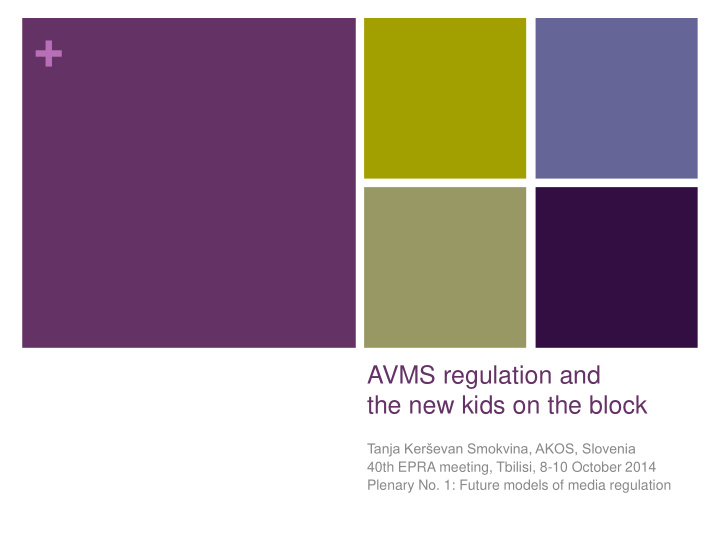



+ AVMS regulation and the new kids on the block Tanja Kerševan Smokvina, AKOS, Slovenia 40th EPRA meeting, Tbilisi, 8-10 October 2014 Plenary No. 1: Future models of media regulation
+ Slovenia and AVMSD, but not only Small market, high penetration of pay-tv, significant share of localized channels from other MSs (subtitled and local advertising, but without national quotas and breaching the hourly ads limit) Linear viewing stable or slightly increasing, but on the account of the population aging (target audience for marketing shifted from 18-49 to 18-55) Children and young adults increasingly non-linear/online/social networking (negligible offer of quality domestic AV content); growing share of smart TVs/phones (5,17 % TV sets with direct access to internet; share of smart phones surpassed regular cellulars in 2011) PSB’s ratings lowering (still reaching significant levels when broadcasting big sports events) No level playing field (domestic/foreign, linear/non-linear/OTT, hybrid services)
+ Slovenia cont. Problems with application of the notion of the independent producer in Slovenia (as there are only a few domestic broadcasters able to purchase such content + lack of info needed to establish „independence“) Lack of new (independent) domestic AV works suitable for broadcasting on commercial TVs (e.g. non-responsiveness to the tender issued by the biggest commercial player) European content too expensive for new/small broadcasters that are not exempt of the obligation (0,3 % audience share in SLO translates to less than 800 viewers in terms of AMR abs) Lack of credible/detailed information on European works (e.g. relations between co-producers, executive vs. others) Problems with application of the 9.00 pm watershed for 12+ (due to the channels from other MSs offering prime time content at 8.00 pm or earlier)
+ Choice/Chaos/Control Communicative abundance (Keane1999), supersaturation (Gitlin 2002), cultural chaos (McNair 2006), polymedia (Medianou and Miller 2011), media manifold (Couldry 2012) Unmatched choice / pluralization of voices with access to the public sphere (Karpinnen 2013), but through the gates controlled by the new gatekeepers with power and no responsibility (Milosavljevic 2014) Digital intermediaries (e.g. ISPs, search engines, hosting providers, platform operators, aggregators) preselect and filter available information (Council of Europe 2012; Hargittai 2007; Hindman 2009; Machill et al. 2008; Milosavljevic 2014), direct the web traffic (Hindman 2009; Karpinnen 2013), influence media consumption and habits (Couldry 2012) and affect the traditional media business models – econoshock (Noels 2014)
+ Distribution of news The most powerful distributor of news: an algorithm governing display of stories to the billion users on Facebook. (Bell 2014) 1/3 SLO population regular users of (Mediana 2014) Source: Milosavljevic 2014
+ Distribution of ads Expected top earners in 2014 in Internet ads in billions USD (eMarketer/WSJ March 2014) 19.1 4.8 2.7 2.6 Source: eMarketer/CampalystBlog
+ Total revenues of a SLO media counterpart By producing: 2 most viewed generalist TV channels, available also on DTT, 3 additional specialized TV channels, available on cable and IPTV, the most popular VOD/catch up TV service and the most clicked online news portal, the company earned: Sales revenues of 100 biggest SLO media in 2013 = 427 million € 50 million EUR in 2013 10% less than in 2012 (MM 2014)
+ What’s at stake Cultural and societal aims of the national media policies (partly due to regulatory arbitrage and tax heavens, but also changing uses and business models) Cultural and societal aims of the EU media policies (due to unlimited strengthening of non-regulated global players) National and EU industrial / economic objectives (due to the lack of level playing field) Focus of content regulation on services with a clear editorial dimension Media ownership rules (concentrating on traditional media)
+ Review of the AV framework could Recognize the role of intermediaries as new media gatekeepers and develop suitable remedies (Re)define and enforce the role of regulators in the new media system(s) and new model(s) of media governance (shift from protect me to inform me, but also encourage me and help me) Explore the ways to influence media quality, accountability and accessibility of various content rather than merely measuring quantity (of EU works, independent productions, ads)
+ Thanks!
Recommend
More recommend